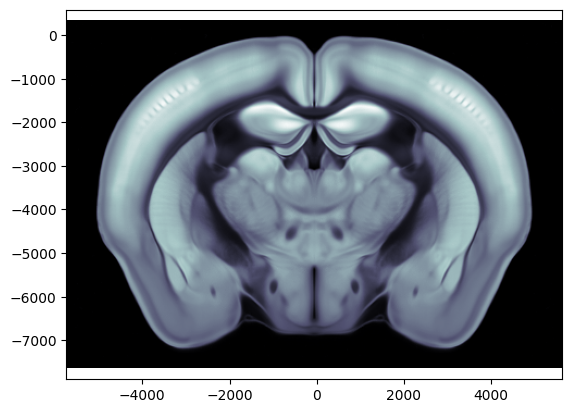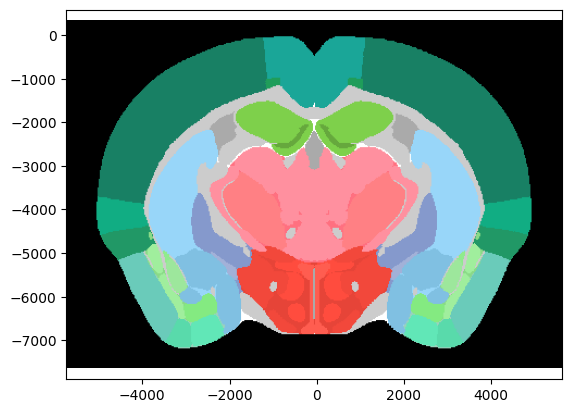Working with IBL atlas object
Getting started
The Allen atlas image and annotation volumes can be accessed using the iblatlas.atlas.AllenAtlas class. Upon instantiating the class for the first time, the relevant files will be downloaded from the Allen database.
[1]:
from iblatlas.atlas import AllenAtlas
res = 25 # resolution of Atlas, available resolutions are 10, 25 (default) and 50
brain_atlas = AllenAtlas(res_um=res)
Exploring the volumes
The brain_atlas class contains two volumes, the diffusion weighted imaging (DWI) image volume and the annotation label volume. Each volume is saved into a matrix of the same shape (i.e. they contain the same number of voxels), as defined by the input resolution res.
1. Image Volume
The image volume contains the Allen atlas DWI average template. DWI images are typically represented in gray-scale colors.
[2]:
# Access the image volume
im = brain_atlas.image
# Explore the size of the image volume (ap, ml, dv)
print(f'Shape of image volume: {im.shape}')
# Plot a coronal slice at ap = -1000um
ap = -1000 / 1e6 # input must be in metres
ax = brain_atlas.plot_cslice(ap, volume='image')
Shape of image volume: (528, 456, 320)

Label Volume
The label volume contains information about which brain region each voxel in the volume belongs to.
[3]:
# Access the label volume
lab = brain_atlas.label
# Explore the size of the label volume (ap, ml, dv)
print(f'Shape of label volume: {lab.shape}')
# Plot a coronal slice at ap = -1000um
ap = -1000 / 1e6 # input must be in metres
ax = brain_atlas.plot_cslice(ap, volume='annotation')
Shape of label volume: (528, 456, 320)

The label volume used in the IBL AllenAtlas class differs from the Allen annotation volume in two ways.
Each voxel has information about the index of the Allen region rather than the Allen atlas id
The volume has been lateralised to differentiate between the left and right hemisphere
To understand this better let’s explore the BrainRegions class that contains information about the Allen structure tree.
Exploring brain regions
Index versus Allen ID
The Allen brain region structure tree can be accessed through the class iblatlas.regions.BrainRegions.
[4]:
from iblatlas.regions import BrainRegions
brain_regions = BrainRegions()
# Alternatively if you already have the AllenAtlas instantiated you can access it as an attribute
brain_regions = brain_atlas.regions
The brain_regions class has the following data attributes
[5]:
brain_regions.__annotations__
Out[5]:
{'id': numpy.ndarray,
'name': object,
'acronym': object,
'rgb': numpy.uint8,
'level': numpy.ndarray,
'parent': numpy.ndarray,
'order': numpy.uint16}
These attributes are the same as the Allen structure tree and for example id corresponds to the Allen atlas id while the name represents the full anatomical brain region name.
The index refers to the index in each of these attribute arrays. For example, index 1 corresponds to the root brain region with an atlas id of 977.
[6]:
index = 1
print(brain_regions.id[index])
print(brain_regions.acronym[index])
997
root
Alternatively, index 1000 corresponds to PPYd with an atlas id of 185
[7]:
index = 1000
print(brain_regions.id[index])
print(brain_regions.acronym[index])
185
PPYd
In the label volume we described above, it is these indices that we are referring to. Therefore, we know all voxels in the volume with a value of 0 will be voxels that lie in root, while the voxels that have a value of 1000 will be in PPYd
[8]:
import numpy as np
root_voxels = np.where(brain_atlas.label == 1)
ppyd_voxels = np.where(brain_atlas.label == 1000)
Voxels outside of the brain are labelled with void, which has the both the index and Allen ID being 0:
[9]:
index_void = 0
print(brain_regions.id[index_void])
print(brain_regions.acronym[index_void])
0
void
As such, you can find all the voxels within the brain by filtering for non-zero indices:
[10]:
vox_in = np.where(brain_regions.id != index_void)
You can jump betwen acronym / id / index with these functions :
[11]:
# From an acronym, get the index and id
acronym = 'MDm'
index = brain_regions.acronym2index(acronym)
id = brain_regions.acronym2id(acronym)
print(f'The acronym {acronym} has the indices {index[1][0]} and Allen id {id[0]}')
# From an id, get the index and acronym
id = 636
acronym = brain_regions.id2acronym(id)
index = brain_regions.id2index(id)
print(f'The Allen id {id} has the acronym {acronym[0]} and the indices {index[1][0]}')
# From a single index, get the id and acronym
# (Note that this returns only 1 value)
index = 2016
id = brain_regions.id[index]
acronym = brain_regions.acronym[index]
print(f'The index {index} has the acronym {acronym} and the Allen id {id}')
The acronym MDm has the indices [ 689 2016] and Allen id 636
The Allen id 636 has the acronym MDm and the indices [ 689 2016]
The index 2016 has the acronym MDm and the Allen id -636
Lateralisation: left/right hemisphere differentiation
An additional nuance is the lateralisation. If you compare the size of the brain_regions data class to the Allen structure tree, you will see that it has double the number of columms. This is because the IBL brain regions encodes both the left and right hemisphere using unique, positive integers (the index), whilst the Allen IDs are signed integers (the sign represents the left or right hemisphere).
[12]:
# Print how many indexes there are
print(brain_regions.id.size)
2655
This is equivalent to 2x the number of unique Allen IDs (positive + negative), plus void (0) that is not lateralised:
[13]:
positive_id = np.where(brain_regions.id>0)[0]
negative_id = np.where(brain_regions.id<0)[0]
void_id = np.where(brain_regions.id==0)[0]
print(len(positive_id) + len(negative_id) + len(void_id))
2655
We can understand this better by exploring the brain_regions.id and brain_regions.name at the indices where it transitions between hemispheres.
The first value of brain_region.id is void (Allen id 0):
[14]:
print(brain_regions.id[index_void])
0
The point of change between right and left hemisphere is at the index:
[15]:
print(len(positive_id))
1327
Around this index, the brain_region.id go from positive Allen atlas ids (right hemisphere) to negative Allen atlas ids (left hemisphere).
[16]:
print(brain_regions.id[1320:1340])
[ 25 34 43 49 57 65
624 304325711 -997 -8 -567 -688
-695 -315 -184 -68 -667 -526157192
-526157196 -526322264]
Regions are organised following the same index ordering in left/right hemisphere. For example, you will find the same acronym PPYd at the index 1000, and once you’ve passed the positive integers:
[17]:
index = 1000
print(brain_regions.acronym[index])
print(brain_regions.acronym[index + len(positive_id)])
# Note: do not re-use this approach, this is for explanation only - you will see below a dedicated function
PPYd
PPYd
The brain_region.name also go from right to left hemisphere:
[18]:
print(brain_regions.name[1320:1340])
['simple fissure' 'intercrural fissure' 'ansoparamedian fissure'
'intraparafloccular fissure' 'paramedian sulcus' 'parafloccular sulcus'
'Interpeduncular fossa' 'retina' 'root (left)'
'Basic cell groups and regions (left)' 'Cerebrum (left)'
'Cerebral cortex (left)' 'Cortical plate (left)' 'Isocortex (left)'
'Frontal pole cerebral cortex (left)' 'Frontal pole layer 1 (left)'
'Frontal pole layer 2/3 (left)' 'Frontal pole layer 5 (left)'
'Frontal pole layer 6a (left)' 'Frontal pole layer 6b (left)']
In the label volume, we can therefore differentiate between left and right hemisphere voxels for the same brain region. First we will use a method in the brain_region class to find out the index of left and right CA1.
[19]:
brain_regions.acronym2index('CA1')
# The first values are the acronyms, the second values are the indices
Out[19]:
(array(['CA1'], dtype=object), [array([ 458, 1785])])
The method acronym2index returns a tuple, with the first value being a list of acronyms passed in and the second value giving the indices in the array that correspond to the left and right hemispheres for this region. We can now use these indices to search in the label volume
[20]:
CA1_right = np.where(brain_atlas.label == 458)
CA1_left = np.where(brain_atlas.label == 1785)
Coordinate systems
The voxels can be translated to 3D space. In the IBL, all xyz coordinates are referenced from Bregma, which point is set as xyz coordinate [0,0,0].

In contrast, in the Allen coordinate framework, the [0,0,0] point corresponds to one of the cubic volume edge.
Below we show the value of Bregma in the Allen CCF space (in micrometer um):
[30]:
from iblatlas.atlas import ALLEN_CCF_LANDMARKS_MLAPDV_UM
print(ALLEN_CCF_LANDMARKS_MLAPDV_UM)
{'bregma': array([5739, 5400, 332])}
To translate this into an index into the volume brain_atlas, you need to divide by the atlas resolution (also in micrometer):
[31]:
# Find bregma position in indices
bregma_index = ALLEN_CCF_LANDMARKS_MLAPDV_UM['bregma'] / brain_atlas.res_um
This index can be passed into brain_atlas.bc.i2xyz that converts volume indices into IBL xyz coordinates (i.e. relative to Bregma):
[32]:
# Find bregma position in xyz in m (expect this to be 0 0 0)
bregma_xyz = brain_atlas.bc.i2xyz(bregma_index)
print(bregma_xyz)
[0. 0. 0.]
Functions exist in both direction, i.e. from a volume index to IBL xyz, and from xyz to an index. Note that the functions return/input values are in meters, not micrometers.
[33]:
# Convert from arbitrary index to xyz position (m) position relative to Bregma
index = np.array([102, 234, 178]).astype(float)
xyz = brain_atlas.bc.i2xyz(index)
print(f'xyz values are in meters: {xyz}')
# Convert from xyz position (m) to index in atlas
xyz = np.array([-325, 4000, 250]) / 1e6
index = brain_atlas.bc.xyz2i(xyz)
xyz values are in meters: [-0.003189 -0.00045 -0.004118]
To know the sign and voxel resolution for each xyz axis, use:
[34]:
# Find the resolution (in meter) of each axis
res_xyz = brain_atlas.bc.dxyz
# Find the sign of each axis
sign_xyz = np.sign(res_xyz)
print(f"Resolution xyz: {res_xyz} in meter \nSign xyz:\t\t{sign_xyz}")
Resolution xyz: [ 2.5e-05 -2.5e-05 -2.5e-05] in meter
Sign xyz: [ 1. -1. -1.]
To jump directly from an Allen xyz value to an IBL xyz value, use brain_atlas.ccf2xyz:
[35]:
# Example: Where is the Allen 0 relative to IBL Bregma?
# This will give the Bregma value shown above (in meters), but with opposite axis sign value
brain_atlas.ccf2xyz(np.array([0, 0, 0]))
Out[35]:
array([-0.005739, 0.0054 , 0.000332])